Middle School Life Science Storytelling
-
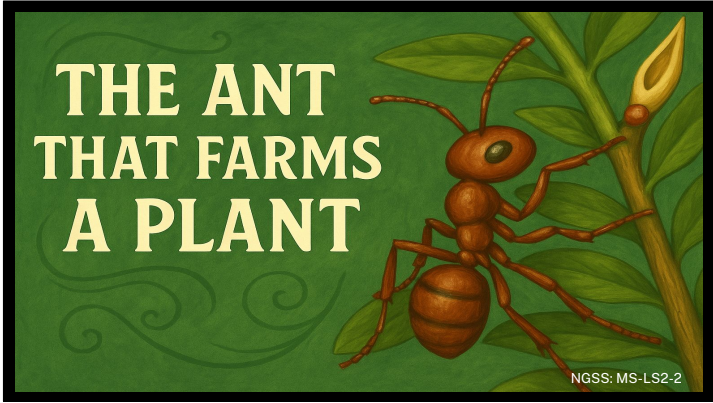
The Ant That Farms a Plant NGSS MS-LS2-2
In the tough African savanna, one tree found an unlikely ally: ants. This story brings to life the fascinating mutualism between Acacia trees and the ants that protect them — showing how organisms can shape each other’s survival. Through leaf-eating invaders, vine-blocking battles, and sugar-water rewards, students explore the power of interdependent relationships and how they shape entire ecosystems.
-

The Banana Time Bomb
What do bananas and genetic variation have in common? Everything — when one disease threatens them all. This story dives into the world of Cavendish bananas, a globally loved fruit that’s genetically identical from plant to plant. Students explore the role of genes, asexual vs. sexual reproduction, and why lack of variation puts entire crops at risk. It's a deliciously relevant entry point into heredity and genetic diversity.
-

The Blind Man Who Sees With Sound NGSS MS-LS1-8
Meet Daniel Kish, a real-life superhero who lost his sight but learned to navigate the world using sound — just like a bat. This inspiring story explores how the human body detects and processes sensory information, and how the brain can adapt when one sense is lost. With engaging science and an unforgettable main character, students learn how sensory receptors and brain processing lead to behavior and survival.
-

The Blue People of Kentucky NGSS MS-LS3-2
Uncover the real-life mystery of a family in the Appalachian Mountains who were born with bright blue skin — and the surprising science behind it. This story introduces students to inherited traits, genetic conditions, and how genes pass through generations. With a blend of medical detective work, mountain folklore, and molecular biology, it brings heredity to life in the most unexpected way.
-

The Bone That Binds Us All NGSS MS-LS4-2
What do a human, a bat, and a whale all have in common? More than you think. This story reveals the hidden similarities in limb structures across species and introduces students to the concept of homologous structures. By tracing shared anatomy back to a common ancestor, students explore how evolutionary relationships are uncovered — not through guesswork, but through bones, fossils, and the architecture inside their own arms.
-

The Case of the Cannibal Crabs NGSS MS-LS2-3
On Christmas Island, red crabs once marched peacefully across the forest floor — until a tiny invader disrupted everything. This story explores how an invasive species, the yellow crazy ant, triggered a cascade of ecological changes that broke the flow of energy and matter. As students follow the shocking twist of crabs turning on each other, they’ll learn how disruptions to food webs can have unexpected and far-reaching effects.
-

The Designer Dog Dilemma NGSS MS-LS2-3
From wolf to woof, dogs have been shaped by human hands — but not always for the better. This story follows the rise of designer dog breeds like pugs, revealing how selective breeding can lead to both adorable traits and serious health problems. Students will explore how humans influence the traits of organisms and weigh the benefits and risks of intentional selection. It’s a thought-provoking look at biology, ethics, and the future of breeding.
-

The Fish With Hands NGSS MS-LS4-1
What do your arms have in common with a 375-million-year-old fish? This story introduces students to Tiktaalik — the fossil that bridges the gap between water and land. As students explore how traits are passed down and modified over generations, they’ll see how fossils provide powerful evidence of evolutionary relationships. It’s a hands-on journey into our distant past, told through the rocks beneath our feet.
-

The Girl Who Couldn't Feel Pain NGSS MS-LS1-3
What happens when your body doesn’t know how to respond to danger? This powerful true story introduces students to Ashlyn, a girl born with a rare condition called Congenital Insensitivity to Pain. As students follow her journey, they’ll uncover how the body receives and responds to information — and why feeling pain is essential to staying safe. It’s a compelling way to explore structure and function in the human nervous system.
-

The Man Who Weighed His Own Poop NGSS MS-LS1-7
Follow the strange but true story of Santorio Santorio — the 1700s doctor who built a giant scale to weigh everything he ate, drank, and excreted. Through this quirky historical tale, students learn how food is chemically broken down, transformed inside the body, and released through various processes. It’s an unforgettable way to explore metabolism, mass conservation, and cellular respiration with humor and scientific depth.
-

The Million Dollar Mosquito NGSS MS-LS2-5
What happens when scientists release genetically modified mosquitoes into the wild? This real-world story dives into the complex balance between solving public health problems and protecting ecosystems. Students will explore how design solutions must weigh tradeoffs — from human safety to environmental impact — as they follow the high-stakes decisions behind mosquito control efforts in Florida and Brazil.
-

The Mosquito That Loved Cities NGSS MS-LS4-4
Beneath the streets of London, a new kind of mosquito was born — one that didn’t need birds, daylight, or even fresh air. This story tracks the real-time evolution of Culex pipiens molestus, a mosquito that adapted to life underground in just a few decades. Students explore how traits become more or less common based on environmental pressures, and how evolution isn’t just ancient history — it’s happening right now, all around us.
-
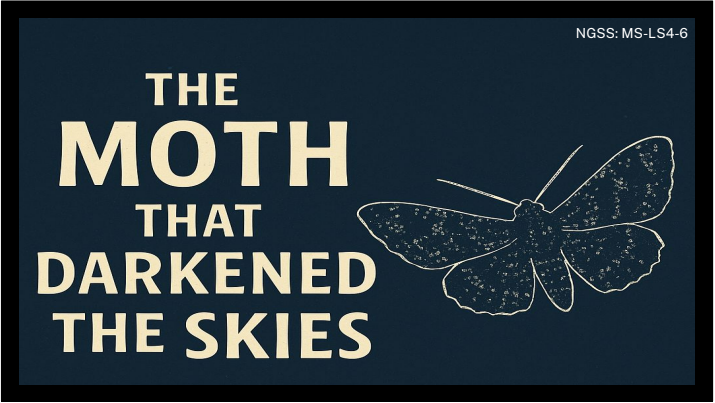
The Moth That Darkened the Skies NGSS MS-LS4-6
When England's trees turned black with soot, the moths changed too. This classic story of the peppered moth brings evolution to life through real data, observable change, and the role of natural selection. Students will examine how environmental pressures — from industrial smoke to modern chemicals — can shift populations, affect survival, and reshape the traits of living things in measurable ways.
-

The Mystery of the Clownfish NGSS MS-LS1-4
Dive into the surprising reproductive strategies of clownfish — where males can become females, and survival depends on adaptability. This story introduces students to the concept of genetic information and how it influences the growth and reproduction of organisms. With real-world animal examples, from seahorses to toads, students explore the diversity of life strategies and the fascinating ways organisms ensure their species continues.
-

The Rabbits That Took Over Australia NGSS MS-LS2-1
Discover how 24 rabbits released for sport turned into an ecological disaster that reshaped an entire continent. This story introduces students to the concept of carrying capacity, limiting factors, and population dynamics through the true tale of Australia’s rabbit invasion. With real-world consequences, exponential growth, and creative (sometimes desperate) solutions, students will explore how ecosystems respond when balance is broken.
-

The Race for the Fastest Growing Cows NGSS MS-LS1-5
Travel to Belgium, where farmers bred a cow that looks like a bodybuilder — and discover how genes and environment shape the traits of living things. This story uses the Belgian Blue cow and other real-world examples like broccoli, chickens, and corn to explore selective breeding. Students will connect how traits are influenced by genetic information and human choices, offering a fun, eye-opening path into heredity and trait variation.
-

The Secret Life of Pond Water NGSS MS-LS1-1
Introduce students to the hidden world of cells by uncovering the curiosity of early scientists and the microscopic mysteries inside a single drop of pond water. This story takes students back to the world before microscopes, follows Antonie van Leeuwenhoek’s strange discoveries, and challenges them to think about what makes something alive.
-
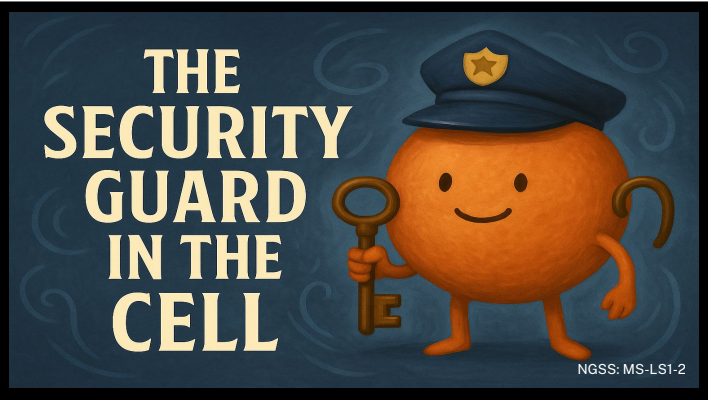
The Security Guard in the Cell NGSS MS-LS1-2
Step into the microscopic world of cellular security systems — where not everything is allowed through the door. This story introduces students to the cell membrane and its role in regulating what enters and exits a cell. With real-world virus examples like HIV, influenza, and COVID-19, students discover how cells defend themselves, how invaders sneak past, and why structure and function matter in the tiniest units of life.
-

The Tails We All Started With NGSS MS-LS4-3
What do humans, fish, and birds all share before birth? More than you’d expect. This story uncovers the hidden similarities in early development, from tails to gill slits, revealing powerful evidence of common ancestry among vertebrates. Students explore embryology, vestigial structures, and the clues written in our DNA — all while learning how life’s story begins with a shared blueprint.
-

The Wolves Who Made the River Change NGSS MS-LS2-4
Journey to Yellowstone National Park to uncover how the return of wolves set off a powerful chain reaction — changing not just animal populations, but the shape of rivers themselves. This story illustrates the concept of trophic cascades and ecosystem dynamics through a compelling true narrative. Students will see how the presence (or absence) of a single species can send ripples through an entire environment.
-

The Victorian Oxygen Bar Craze NGSS MS-LS1-6
Step into smoggy Victorian London, where people gathered in plant-filled rooms hoping to breathe cleaner air — and uncover the science behind their good intentions. This story explores how photosynthesis works, what conditions it needs, and why light matters. It blends historical curiosity with modern myths about oxygen, helping students connect plant function to real-world applications (and misunderstandings).
Middle School Earth Science Storytelling
-

The Day the Storms Collided NGSS MS-ESS2-5
Students follow the dramatic collision of atmospheric systems to understand how differences in air pressure, temperature, and moisture create weather patterns. Through this real-world event, they’ll explore how energy flows between Earth’s systems and why air masses and fronts are central to extreme weather events. It’s a gripping introduction to meteorology through story-driven science.
-
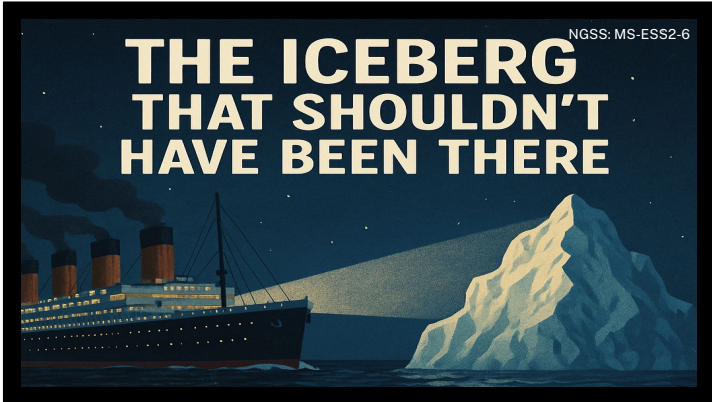
The Iceberg That Shouldn't Have Been There NGSS MS-ESS2-6
The Titanic wasn’t just a tragedy — it was a lesson in ocean science. This story takes students beneath the surface to understand how currents like the Gulf Stream and Labrador Current carry thermal energy and regulate Earth’s systems. With a blend of history and Earth science, students will explore how ocean circulation impacts climate, navigation, and the delicate balance of Earth’s oceans.
-

The Moon That Disappeared NGSS MS-ESS1-1
In 1504, Columbus was stranded, starving, and running out of options. So he made a bold prediction: the Moon would vanish. Students will explore the science behind lunar eclipses, how patterns in Earth’s motion help us model astronomical events, and how those patterns have been used throughout history. This story turns the sky into a classroom and history into a hook for learning real science.
-

The Moon That Won't Stay Put NGSS MS-ESS1-2
Students follow the dramatic collision of atmospheric systems to understand how differences in air pressure, temperature, and moisture create weather patterns. Through this real-world event, they’ll explore how energy flows between Earth’s systems and why air masses and fronts are central to extreme weather events. It’s a gripping introduction to meteorology through story-driven science.
-
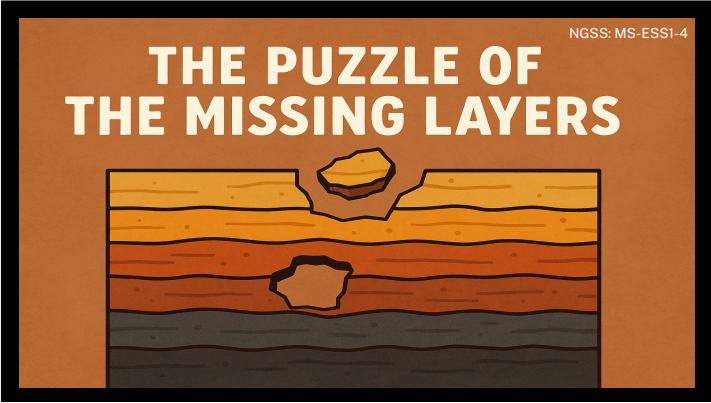
The Puzzle of the Missing Layers NGSS MS-ESS1-4
When geologists looked into the Grand Canyon, they found more than layers — they found a hole in time. This story shows students how unconformities reveal Earth’s dynamic processes like uplift, erosion, and sea-level change. With real-world context and a mystery to solve, it transforms abstract concepts into a detective story millions of years in the making.
-

The River That Carved a Canyon NGSS MS-ESS2-2
Step by step and drop by drop, this story shows how Earth’s surface is shaped by natural forces. Students explore the roles of water, ice, wind, and tectonic uplift in changing landforms over time. With real-world relevance and vivid visuals, it’s a story of slow transformation that leaves a lasting impression.
-

The River That Turned Toxic NGSS MS-ESS3-4
For thousands of years, the Yamuna River brought life to one of the world’s largest cities — until pollution pushed it to the brink. In this story, students explore how wastewater, chemical runoff, and population growth transformed a cultural icon into a crisis. Then, they examine how engineers, scientists, and everyday citizens are stepping up with real-world solutions. It’s a powerful look at cause, consequence, and the path to environmental recovery.
-

The Smog That Hid the Sun NGSS MS-ESS3-3
In December 1952, the city of London was swallowed by a deadly smog that blocked out the Sun and took thousands of lives. This story helps students understand the science of air pollution, temperature inversions, and particulate matter — while exploring how one environmental tragedy led to major policy change. It’s a compelling look at the impact of human activity on Earth’s systems — and how science can help us clear the air.
-

The Space Trip You'll Never Finish NGSS MS-ESS1-3
How far is far? Students find out as they journey from the Moon to Mars, past Pluto, and into the stars. Along the way, they explore units like astronomical units and light-years while discovering how models help us visualize and measure the unimaginable. With a mix of history, science, and scale, this story transforms space from overwhelming to unforgettable.
-

The Supervolcano That Froze Summer NGSS MS-ESS2-1
From massive explosions to microscopic ash, this story shows how Earth’s geosphere, atmosphere, hydrosphere, and biosphere are all connected. Students follow the cascading impacts of a supervolcano eruption to understand how energy flows and matter cycles through Earth’s systems. It’s a dramatic, real-world example of how one event can reshape the entire planet.
-

The Town That Sank From Below NGSS MS-ESS2-4
At first, it was just a cracked driveway. Then, it was rooftops dropping and farmland shifting. Students explore how geoscience processes — including water extraction and land compaction — can dramatically alter Earth’s surface. This powerful story connects human activity to real-world consequences and reveals how science can guide better decisions for the future.
-

The Town That Sits on a Billion Barrels NGSS MS-ESS3-1
This story dives into Earth’s deep past to explain a modern energy hotspot. Through the lens of geology, students explore how marine life, sedimentation, pressure, and time transformed into the fossil fuels that power our world today. It’s an engaging look at Earth science, resource management, and the double-edged sword of energy dependence.
-

The Town That Watched The Glacier Disappear NGSS MS-ESS3-5
In Glacier Bay, Alaska, a towering wall of ancient ice once stood in view — until it slowly vanished. Through real data, ice cores, and rising CO₂ levels, students explore how human activities contribute to changes in Earth’s climate. This powerful story makes abstract concepts like greenhouse gases and global warming feel personal, urgent, and grounded in evidence students can see and understand.
-

Alfred's Theory Nobody Believed NGSS MS-ESS2-3
Long before ocean floor mapping and GPS data, a scientist with a map and a bold idea challenged the scientific world. In this story, students learn how Wegener’s theory was built on fossil, climate, and rock evidence — and why good science often means sticking with the facts, even when no one else agrees. It’s an inspiring tale of perseverance, discovery, and how Earth’s surface is always in motion.
-

The Wave That Came Without Warning NGSS MS-ESS3-2
On the morning of December 26, 2004, an invisible shift beneath the ocean triggered one of the deadliest disasters in modern history. This story follows the science behind the Indian Ocean tsunami — from tectonic pressure to tragic consequences — and highlights how natural hazard data and warning systems can reduce risk. Students learn why preparedness matters and how science, technology, and education can save lives when Earth’s forces strike without warning.
Middle School Physical Science Storytelling
-

The Alchemists Who Failed NGSS MS-PS1-5
From mystical potions to scientific precision, this story explores the shift from alchemy to chemistry. Students learn how careful experiments led to the law of conservation of mass and why modern science depends on it. With historical twists and atomic truths, it’s a perfect way to make foundational chemistry unforgettable.
-

The Alarm That Could Have Ended The World NGSS MS-PS4-3
What’s the difference between analog and digital — and why does it matter? In this gripping story, students compare signal types by exploring how analog data can be distorted, and how digital encoding provides clarity and accuracy in life-or-death situations. It’s a high-stakes lesson in science, technology, and critical thinking.
-

The Car That Changed Safety Forever NGSS MS-PS2-1
When a car stops suddenly, passengers don’t. This story brings Newton’s Third Law into sharp focus, showing how seatbelts create an equal and opposite force that keeps people safe. Students explore motion, collisions, and the real-world physics that goes into every safety feature on the road today.
-

The Car That Jumped the River NGSS MS-PS2-2
Evel Knievel needed serious thrust to overcome gravity — but physics had other plans. In this story, students learn how the motion of an object depends on the sum of forces acting on it and its mass. It’s a thrilling look at Newton’s Second Law, told through real calculations, daring ambition, and a high-stakes launch that didn’t go as planned.
-

The Chocolate That Didn't Melt NGSS MS-PS3-3
As energy flows into chocolate, particles speed up — until it melts. But what if you could slow that energy down? In this story, students explore how heat is transferred through conduction and how scientists manipulated ingredients and packaging to reduce that transfer. It’s a sweet and surprising application of thermal energy in real life.
-

The Color That Could Kill NGSS MS-PS1-3
From coal tar to catwalks, this story follows the chemistry behind synthetic materials and the evidence that reveals their effects. Students examine how molecular structure and composition determine chemical properties — and how data from history helped shape the modern chemical industry. It’s a vivid, real-world look at chemistry in society.
-

The Compass That Saved Sailors NGSS MS-PS2-5
From lodestones to modern compasses, this story explores how magnetic forces act at a distance and why Earth behaves like a giant magnet. Students will visualize magnetic field lines, learn the difference between geographic and magnetic north, and uncover how a quiet, invisible force made world exploration possible.
-

The Elevator That Fell 75 Floors NGSS MS-PS3-2
From gravitational potential energy to compressed air and tangled cables, this story helps students visualize how energy transforms and transfers during motion. With a real event as the anchor, students explore the relationship between mass, speed, and energy — and how understanding those relationships can mean the difference between disaster and survival.
-

The Invisible Plane NGSS MS-PS4-2
How do you make a plane disappear without magic? This story explores how radar uses waves to detect objects — and how stealth aircraft use angled surfaces and specialized materials to reflect or absorb those waves. Students will uncover the science behind invisibility, where every surface is engineered to answer one question: Where does the wave go?
-

The Lightning That Shattered Ben's Kite NGSS MS-PS2-3
What makes a spark leap through the air? In this story, students explore electric charge, fields, and the forces that cause lightning to strike. From spark gap experiments to modern safety systems, they’ll discover how differences in charge create powerful forces — and how one man’s curiosity helped shape our understanding of electricity.
-
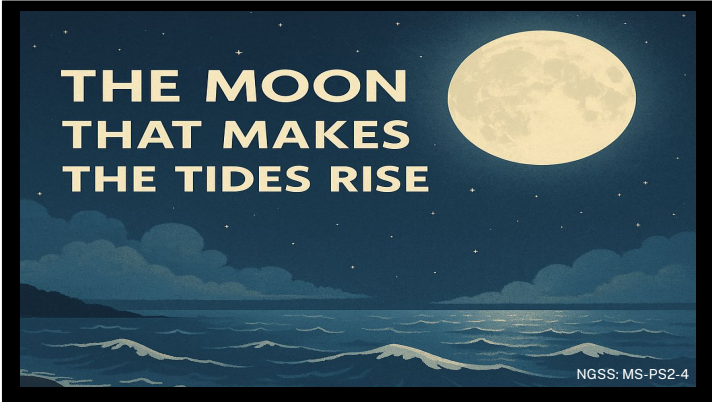
The Moon That Makes the Tides Rise NGSS MS-PS2-4
Why does the ocean rise and fall like clockwork? In this story, students follow Newton’s question about gravity across space, discovering how the Moon pulls on Earth’s water to create high and low tides. With historical clues, cosmic motion, and real-world impact, this lesson makes gravity feel both massive and beautifully subtle.
-
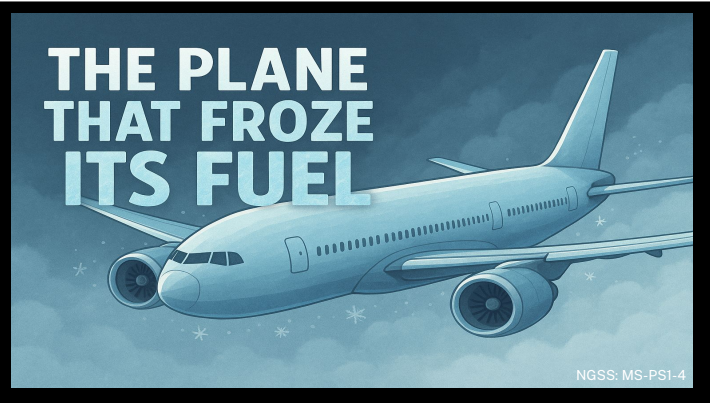
The Plane That Froze Its Fuel NGSS MS-PS1-4
At 35,000 feet, jet fuel should flow smoothly — but when particles slow and wax crystals form, the consequences can be catastrophic. This story helps students explore how thermal energy affects matter, how mixtures freeze differently than pure substances, and how understanding particle motion leads to real-world engineering solutions. It’s chemistry, physics, and flight safety rolled into one unforgettable story.
-

The Road That Melted NGSS MS-PS3-4
Why did roads melt while sidewalks stayed solid? In this story, students investigate how energy moves from sunlight into different materials, and why some absorb and respond to heat more dramatically than others. Through real-world consequences and engineering solutions, students connect science to everyday survival in a warming world.
-

The Rocket That Went Too Fast NGSS MS-PS3-1
In 1959, a rocket launched toward the Moon — and missed. But that "failure" revealed something powerful: when speed is high enough, energy can carry a spacecraft past gravity's grip. This story breaks down the relationship between mass, velocity, and kinetic energy in a memorable, real-world context that connects physics to exploration.
-

The Rust That Ate a Bridge NGSS MS-PS1-2
Not all chemical reactions are fast — and some are deadly. In this story, students learn to distinguish between physical and chemical changes by exploring how rust forms, how it weakens materials over time, and how understanding new substances and properties is essential to safety and design. It’s chemistry with real-world consequences.
-

The Salt That Built a City NGSS MS-PS1-1
From Sahara trade caravans to atomic bonds, this story explores how the structure of matter determines its properties. Students meet sodium and chlorine as individual atoms and see how their electron behavior creates ionic bonds and perfect cube-shaped crystals. It’s a fascinating blend of history and chemistry that makes matter meaningful.
-

The Space Shuttle That Couldn't Overheat NGSS MS-PS1-6
Falling to Earth at over 17,000 miles per hour, a spacecraft faces temperatures hotter than molten lava. Students learn how ablative heat shields work, how energy is absorbed or released during chemical changes, and how thermal energy flows during real-world events. It’s a dramatic and unforgettable lesson in why chemistry can save lives.
-

The Tsunami That Flattened Cities NGSS MS-PS3-5
Students trace the journey of energy as it transfers from Earth’s crust into the ocean and finally onto land — changing forms but never disappearing. With real-world consequences and gripping visuals, this story helps students understand how energy moves through systems, and why early detection and preparation matter in saving lives.
-
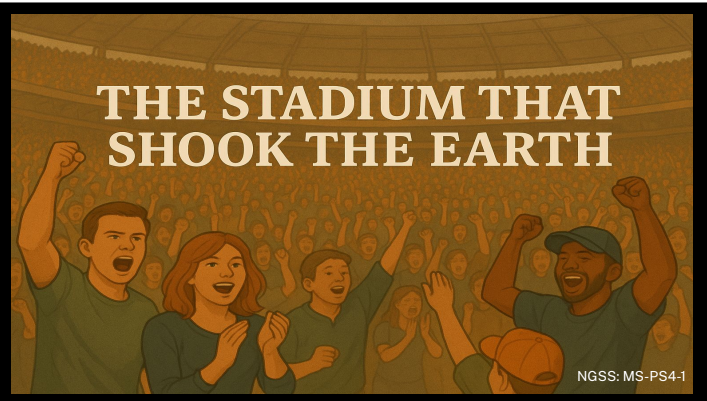
The Stadium That Shook The Ground NGSS MS-PS4-1
What is a wave, really? In this story, students explore how sound waves, seismic waves, and amplitude all relate to energy transfer. By comparing stadium noise to earthquake tremors, they’ll learn how wave properties like frequency and amplitude determine the energy carried — and how those invisible forces can leave a very real impact.